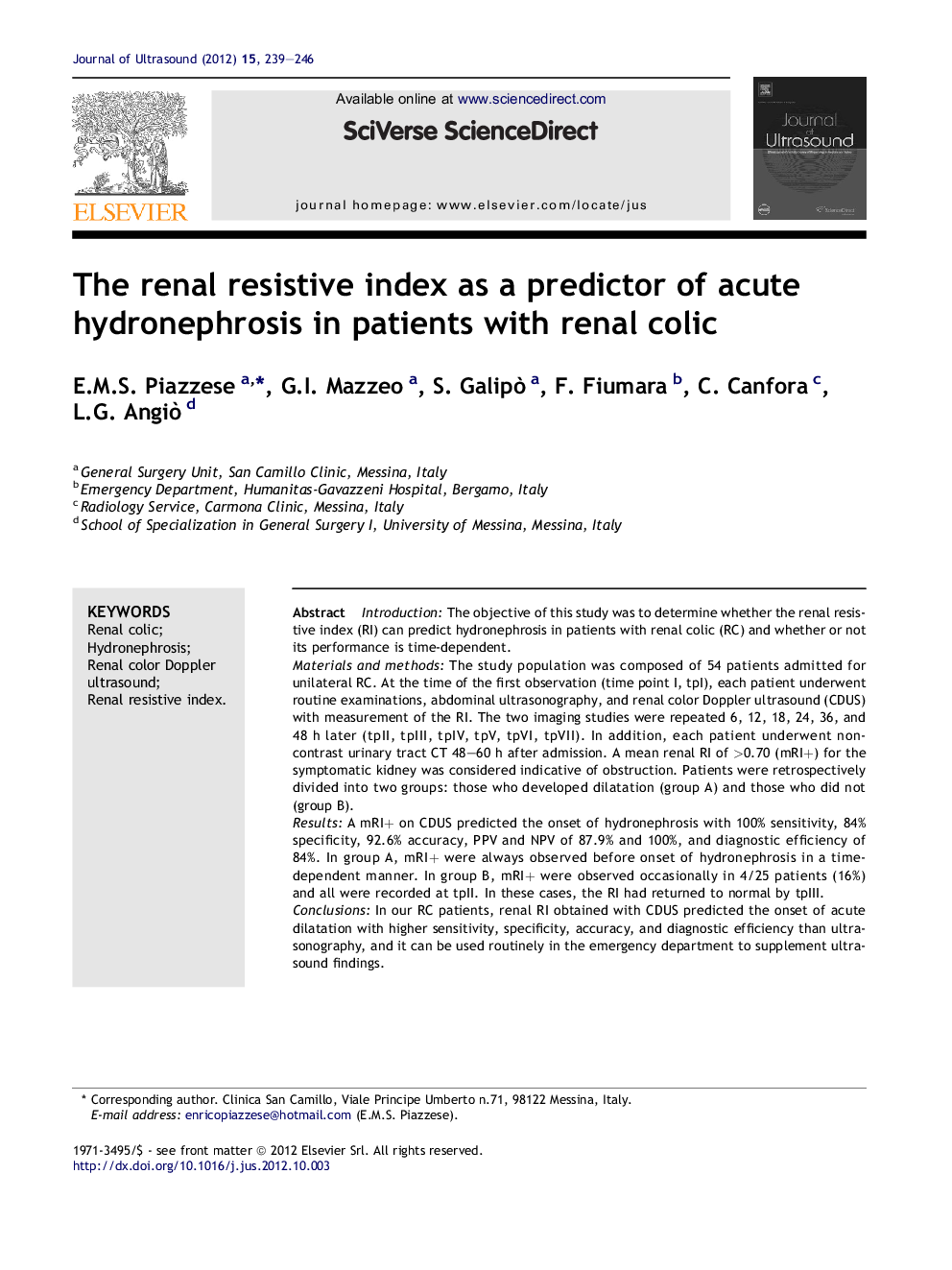| کد مقاله | کد نشریه | سال انتشار | مقاله انگلیسی | نسخه تمام متن |
|---|---|---|---|---|
| 4236736 | 1610298 | 2012 | 8 صفحه PDF | دانلود رایگان |

IntroductionThe objective of this study was to determine whether the renal resistive index (RI) can predict hydronephrosis in patients with renal colic (RC) and whether or not its performance is time-dependent.Materials and methodsThe study population was composed of 54 patients admitted for unilateral RC. At the time of the first observation (time point I, tpI), each patient underwent routine examinations, abdominal ultrasonography, and renal color Doppler ultrasound (CDUS) with measurement of the RI. The two imaging studies were repeated 6, 12, 18, 24, 36, and 48 h later (tpII, tpIII, tpIV, tpV, tpVI, tpVII). In addition, each patient underwent non-contrast urinary tract CT 48–60 h after admission. A mean renal RI of >0.70 (mRI+) for the symptomatic kidney was considered indicative of obstruction. Patients were retrospectively divided into two groups: those who developed dilatation (group A) and those who did not (group B).ResultsA mRI+ on CDUS predicted the onset of hydronephrosis with 100% sensitivity, 84% specificity, 92.6% accuracy, PPV and NPV of 87.9% and 100%, and diagnostic efficiency of 84%. In group A, mRI+ were always observed before onset of hydronephrosis in a time-dependent manner. In group B, mRI+ were observed occasionally in 4/25 patients (16%) and all were recorded at tpII. In these cases, the RI had returned to normal by tpIII.ConclusionsIn our RC patients, renal RI obtained with CDUS predicted the onset of acute dilatation with higher sensitivity, specificity, accuracy, and diagnostic efficiency than ultrasonography, and it can be used routinely in the emergency department to supplement ultrasound findings.
SommarioIntroduzioneObiettivo di questo studio è stato verificare se l’Indice di Resistenza Renale (IR) possa essere considerato un parametro predittivo dell'insorgenza dell'idronefrosi (IN) in caso di colica renale (CR) monolaterale e se esso è tempo correlato.Materiali e metodiLo studio ha incluso 54 pazienti ricoverati per CR monolaterale. Al momento della prima osservazione (time point I) tutti i pazienti sono stati sottoposti a esami routinari, a Ecografia addome e a Eco color Doppler renale (ECD) bilaterale con misurazione dell’IR. Dopo 6 (tpII), 12 (tpIII), 18 (tpIV), 24 (tpV), 36 (tpVI) e 48 (tpVII) ore è stata ripetuta l’ecografia dell’apparato urinario e l’ECD con la misurazione bilaterale dell'IR. A 48–60 ore dal ricovero inoltre tutti i pazienti sono stati sottoposti a TC dell’apparato urinario senza mezzo di contrasto. Un valore medio di IR maggiore di 0,70 (mRI+) a livello del rene sintomatico è stato considerato come suggestivo di ostruzione. I pazienti, in relazione allo sviluppo di IN, sono stati suddivisi a posteriori in gruppo A (dilatazione presente) e B (dilatazione assente).RisultatiL’ECD con il rilevamento dei valori mRI+ ha mostrato un significativo valore diagnostico relativamente all’insorgenza dell’IN con una sensibilità del 100%, specificità 84%, accuratezza 92,6%, VPP 87,9%, VPN 100% ed efficienza diagnostica 84%. Inoltre, nel gruppo A, i valori mRI+ sono stati registrati sempre precocemente rispetto all’insorgenza dell’idronefrosi e in modo tempo correlato. Anche nel gruppo B sono stati registrati alcuni mRI+, ma solo in 4/25 pazienti (16%) e tutti al time point II; in questi casi comunque i valori di mIR sono rientrati nei range della normalità già nel time point successivo.ConclusioniNel nostro studio l’ECD con la misurazione dell’IR si è dimostrato capace di diagnosticare anticipatamente l’insorgenza della dilatazione acuta con livelli di sensibilità, specificità, accuratezza ed efficienza diagnostica superiori all’ecografia; si può prospettare quindi il suo impiego routinario nei reparti di emergenza ad integrazione dell’ecografia.
Journal: Journal of Ultrasound - Volume 15, Issue 4, December 2012, Pages 239–246